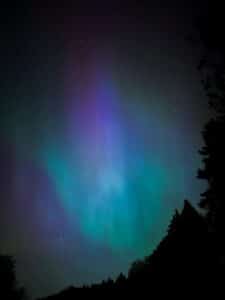Johannah Bernstein post: "eternally proud of my father’s extraordinary aeronautical engineering. legacy. here is a photo of the Canadair Water…
Space: the final frontier January 2024-
Written by Diana Thebaud Nicholson // June 5, 2025 // Aviation & Aerospace // Comments Off on Space: the final frontier January 2024-
Houston, We Have a Breakup
The end of the Trump-Musk bromance could be even worse for space than major cuts to NASA’s budget.
President Donald Trump sure has a unique way of putting “America First in Space.” His team wants to slash NASA’s budget by 25% and shrink its science funding by 47% — “the smallest White House allocation request for NASA since 1961, the year that the first American flew into space,” notes Adam Minter. Trump also withdrew the nomination of Jared Isaacman, who was hailed on one of those Trump-friendly bro-casts as “a visionary leader.” And just this afternoon, he threatened to terminate the government contracts of all of Elon Musk’s companies, including SpaceX:
30 May
NASA budget would cancel dozens of science missions, lay off thousands
(SpaceNews) NASA released more information about its proposed fiscal year 2026 budget May 30, outlining new investments in exploration at the expense of canceling dozens of science missions and cutting thousands of jobs.
The documents provide greater detail about the top-level budget proposal from what the White House’s Office of Management and Budget (OMB) disclosed in its “skinny” budget released four weeks earlier. NASA published the budget documents on its website late on a Friday with no fanfare and without the traditional budget briefing by agency leadership.
That top-level budget of $18.8 billion would be a cut of about a quarter from the nearly $24.9 billion it received in fiscal year 2025. That is the sharpest year-over-year cut proposed for NASA and would bring the agency’s budget down to levels last seen in 1961 when corrected for inflation.
With the budget cuts will come jobs cuts at NASA. A table in the budget document notes that NASA has 17,391 direct-funded civil servants in fiscal year 2025, but that would drop to 11,853 under the fiscal year 2026 proposal, a cut of one-third.
The documents confirm steep cuts in NASA’s science programs. NASA is proposing $3.9 billion for all of NASA science in fiscal year 2026, a 47% cut from what the agency received in 2025.
Those reductions come in large part from canceling many science missions still in development or in extended operations after completing their primary missions. Casey Dreier, chief of space policy at The Planetary Society, said in an interview that more than 40 science projects, including standalone missions and contributions to other missions, were zeroed out in the budget.
31 March
Astronauts Emphasize Gratitude as NASA Contends With Uncertainty
Suni Williams and Butch Wilmore spoke in their first news conference since returning to Earth two weeks ago from an unexpectedly long I.S.S. stay that lasted more than nine months.
Ms. Williams and her fellow astronaut Butch Wilmore repeatedly expressed gratitude. During Ms. Williams’s remarks, she thanked the two astronauts who had shared the SpaceX Crew Dragon capsule that gave them a ride back to Earth. She thanked NASA. She thanked SpaceX. She thanked Boeing. She thanked the medical team that helped them get accustomed to gravity again.
Those words of gratitude may have been appreciated by people at the space agency who — like many federal workers — are uncertain about their mission, their direction or even their continued employment since President Trump’s inauguration.
Elon Musk and his Department of Government Efficiency aim to demolish swaths of the federal bureaucracy. At the same time, Mr. Musk, the chief executive of SpaceX, also dreams of sending colonists to Mars, fueling speculation that NASA’s current centerpiece — the Artemis program, which is focused on sending astronauts back to the moon — could pivot to Mr. Musk’s preferences and that other parts of the agency working on climate change, planetary science and astrophysical research could be slashed.
18 March
Welcome Home! NASA’s SpaceX Crew-9 Back on Earth After Science Mission
(NASA) NASA’s SpaceX Crew-9 completed the agency’s ninth commercial crew rotation mission to the International Space Station on Tuesday, splashing down safely in a SpaceX Dragon spacecraft off the coast of Tallahassee, Florida, in the Gulf of America Mexico.
NASA astronauts Nick Hague, Suni Williams, and Butch Wilmore, and Roscosmos cosmonaut Aleksandr Gorbunov, returned to Earth at 5:57 p.m. EDT. Teams aboard SpaceX recovery vessels retrieved the spacecraft and its crew as a pod of dolphins celebrated around the fast boats and Dragon.
NASA Astronauts Finally Head Home After Nine Months in Orbit
Summary by Bloomberg AI
Two NASA astronauts, Butch Wilmore and Suni Williams, are returning home in a SpaceX craft after being stuck in orbit for nine months.
The astronauts undocked from the International Space Station and are expected to splash down off the Florida coast, where they will undergo medical checks and be reunited with their families.
The situation highlighted NASA’s dependence on SpaceX and was a setback for Boeing’s space business, which has faced technical issues and leadership changes.
Wilmore and Williams arrived at the ISS last June on a Boeing spacecraft with plans to spend roughly a week in space. But that brief trip turned into roughly nine months when NASA decided in August the pair would come home on a rival SpaceX capsule instead, due to technical issues with their Boeing vehicle.
Their saga became an international spectacle, with some media outlets dubbing them the “stranded” astronauts — a nod to NASA’s reluctance to have them fly home in their original spacecraft. The ordeal put an embarrassing spotlight on Boeing’s struggling space business after the company was rocked by a series of crises that forced a change in senior leadership.
2024
NASA 2024: Onward and Upward (YouTube)
Aerospace And Defense In 2024: What To Watch For
Search for Extraterrestrial Intelligence (SETI)
Key People To Watch In The Space Sector In 2024
NASA 2024: Onward and Upward (YouTube)
Landing science on the Moon, demonstrating quiet supersonic aircraft, and launching two new Earth climate satellites, plus a mission to Europa, one of Jupiter’s icy moons, are just a FEW of the milestones we have planned for 2024.
How Sarah Al Amiri Is Launching the UAE Into the Asteroid Belt
She helped lead a young space agency to Mars. Now she has her sights set further into the galaxy. (Sept. 2023)
UAE launches space academy for Emiratis to boost growing sector
Sarah Al Amiri, chairwoman of the Space Agency, says centre will equip citizens with vital skills
The UAE has established a dedicated academy to help future generations of Emiratis build careers in the growing space sector.
The academy will offer an educational, research and practical environment allowing Emirati students to explore and create new technology, including learning how to design spacecraft and plan for missions.
The project is part of a Dh3 billion ($820 million) space fund that was announced last year. (Nov 2023)
18-19 December
Drones banned in parts of New Jersey for one month unless issued permission
Federal Aviation Administration issues ban following dozens of night-time drone sightings reported across the state
Drone detectors in New Jersey have found ‘little or no evidence’ of wrongdoing, governor says
(AP) — Drone-detecting devices deployed in New Jersey in the past week have found “little to no evidence” of anything nefarious or threatening, Gov. Phil Murphy said Monday as calls grew for action to address the mysterious nighttime sightings of suspected unmanned flights across the northeastern U.S.
Drone sightings unsettle New Jersey residents: ‘It’s been super-scary’
As reports of lights in the sky inundate state police, some dismiss them as much ado about nothing. Others think there must be a more detailed explanation.
New Jersey State Police have been inundated with reports of drones since Nov. 18. Federal authorities said in a Saturday briefing to reporters that many are likely commercially available drones, and many others were misidentified planes flying much higher than hobbyists’ drones could hope to.
13-14 November
New Pentagon report on UFOs includes hundreds of new incidents but no evidence of aliens
(AP) — The Pentagon’s latest report on UFOs has revealed hundreds of new reports of unidentified and unexplained aerial phenomena but no indications suggesting an extraterrestrial origin.
The review includes hundreds of cases of misidentified balloons, birds and satellites as well as some that defy easy explanation, such as a near-miss between a commercial airliner and a mysterious object off the coast of New York.
While it isn’t likely to settle any debates over the existence of alien life, the report reflects heightened public interest in the topic and the government’s efforts to provide some answers. Its publication comes a day after House lawmakers called for greater government transparency during a hearing on unidentified anomalous phenomena, or UAPs — the government’s term for UFOs.
Federal efforts to study and identify UAPs have focused on potential threats to national security or air safety and not their science fiction aspects. Officials at the Pentagon office created in 2022 to track UAPs, known as the All-Domain Anomaly Resolution Office, or AARO, have said there’s no indication any of the cases they looked into have unearthly origins.
Congressional UFO Hearing Features Eye-Opening UAP Claims
(Forbes) There was a very X-Files vibe to a congressional hearing into unidentified anomalous phenomena on Wednesday. Witness testimony included eyebrow-raising claims about the existence of UAPs and alien technology on Earth. The hearing was focused on testimony with little substantive evidence behind some of the more extraordinary claims.
The House Oversight Committee joint subcommittee hearing was called “Unidentified Anomalous Phenomena: Exposing the Truth.” The hearing aimed “to further pull back the curtain on secret UAP research programs conducted by the United States government, and undisclosed findings they have yielded.” The four witnesses were retired U.S. Navy Rear Admiral Tim Gallaudet, former Department of Defense official Luis Elizondo, NASA UAP independent study team member Michael Gold and journalist Michael Shellenberger.
UAP is the hot new term that encompasses unidentified flying objects, better known as UFOs. UAP tries to avoid some of the alien-soaked stigma of the term “UFO.” In its broadest sense, it can also include objects or activities spotted in the sea or in space.
UAP does not necessarily imply a connection to aliens from beyond our planet. A Pentagon UAP probe earlier in the year found no evidence of extraterrestrials or government cover-ups of extraterrestrial technology or contact. Still, the report noted many UAP sightings remain unidentified. The Pentagon has taken some steps to be more transparent about UAPs in recent years, including releasing videos of Navy pilot encounters with unidentified objects.
Hearing on Unidentified Anomalous Phenomena
Subcommittees of the House Oversight and Accountability Committee held a joint hearing on alleged government research of Unidentified Anomalous Phenomena. Independent journalist Michael Shellenberger testified on an allegedly secret government program, “Immaculate Constellation,” and he submitted a report by an anonymous whistleblower alleging that the Defense Department and intelligence community withheld evidence to the public about UAPs. Other witnesses included former Defense Department and NASA officials.
Experts testify before lawmakers that the U.S. is running secret UAP programs
(NPR) Is intelligent alien life darting around in space — and even in the skies above us here on Earth? Has the U.S. government been covering up unexplained phenomena, and using secret extraterrestrial discoveries to boost its own technology?
Those are among the questions members of Congress discussed Wednesday in a joint hearing by subcommittees of the House Oversight Committee. Its title: “Unidentified Anomalous Phenomena: Exposing the Truth.”
6 August
China launches rocket carrying new constellation of satellites
China says it launched a rocket Tuesday carrying a constellation of 18 satellites as part of its efforts to assert its presence in space. The satellites were launched early Tuesday afternoon from the Taiyuan Satellite Launch Center in north China’s Shanxi Province aboard a Long March-6 carrier rocket. The official Xinhua News Agency said the rocket had reached its pre-programmed orbit without incident. China’s space program has launched numerous crewed missions, put a space station into orbit with a revolving crew of three astronauts aboard and sent a rover to the moon that has brought back rocks and soil. It has also launched the Beidou System of satellites for national security, communications and scientific purposes, seen as an alternative — or possible competitor — to the GPS system widely used for navigation that is mainly helmed by China’s strategic rival, the United States.
5 June
LIFTOFF! NASA Astronauts Pilot First Starliner Crewed Test to Station
(NASA) A United Launch Alliance Atlas V rocket with Boeing’s Starliner spacecraft aboard launched from Space Launch Complex 41 at Cape Canaveral Space Force Station. NASA’s Boeing Crew Flight Test is the first launch with astronauts of the Boeing spacecraft and United Launch Alliance Atlas V rocket to the International Space Station as part of the agency’s Commercial Crew Program.
NASA astronauts Butch Wilmore and Suni Williams are safely in orbit on the first crewed flight test aboard Boeing’s Starliner spacecraft bound for the International Space Station.
10 May
Aurora borealis lights up the night sky (photos)
A solar storm is bringing spectacular displays of the northern lights, also known as aurora borealis, to the night sky.
 No blackouts reported as Quebecers take in spectacular solar storm
No blackouts reported as Quebecers take in spectacular solar storm
The geomagnetic storm currently affecting the Earth did not cause any power outages in Quebec, leaving its mark on the sky instead, as aurora borealis were spotted in several locations across the province on Friday night. CTV Solar storm lights up Quebec skies with northern lights with Photo gallery.
Solar storm hits Earth, producing colorful light shows across Northern Hemisphere
The aurora borealis has lit up the night sky with rare sightings across the UK, Europe and the northern hemisphere.
(AP) — An unusually strong solar storm hitting Earth produced stunning displays of color in the skies across the Northern Hemisphere early Saturday, with no immediate reports of disruptions to power and communications.
The U.S. National Oceanic and Atmospheric Administration issued a rare severe geomagnetic storm warning when a solar outburst reached Earth on Friday afternoon, hours sooner than anticipated. The effects of the Northern Lights, which were prominently on display in Britain, were due to last through the weekend and possibly into next week.
Aurora displays occur when charged particles collide with gases in the Earth’s atmosphere around the magnetic poles.
In the northern hemisphere, most of this activity takes place within a band known as the aurora oval, covering latitudes between 60 and 75 degrees. When activity is strong, this expands to cover a greater area – which is why displays can be occasionally seen further south.
23 April
Voyager 1 transmitting data again after Nasa remotely fixes 46-year-old probe
Engineers spent months working to repair link with Earth’s most distant spacecraft, says space agency
 6-8 April
6-8 April
CTV National News: An awe inspiring eclipse
People in North America gathered at spots across the path of totality to watch the solar eclipse.
Total solar eclipse 2024 thrills millions across North America (video, photos)
The total solar eclipse was one of the most-watched eclipses ever.
The path of totality crossed four states in Mexico (Sinaloa, Nayarit, Durango and Coahuila) before sweeping over 15 U.S. states (Texas, Oklahoma, Arkansas, Missouri, Illinois, Kentucky, Tennessee, Michigan, Indiana, Ohio, Pennsylvania, New York, Vermont, New Hampshire, and Maine) and seven Canadian Provinces (Ontario, Quebec, New Brunswick, Prince Edward Island, Nova Scotia and Newfoundland).
Some 31.6 million people live in the totality path in the U.S. alone, NASA officials have said.
The off-the-beaten-path faces and places of the total eclipse in Montreal
While Montreal’s downtown may have been in the path of totality of Monday’s eclipse, it certainly wasn’t destination No. 1 for many viewers.
Shortly after noon, streets near the city’s bridges began to fill with cars leaving the island for the viewing experience.
Hundreds of thousands headed off-island — where they could see the eclipse outside of a busy city, free of skyscrapers and noise from construction crews — or to nearby landmarks, such as Sainte-Hélène Island on the St. Lawrence River, where activities had been planned for months.
Solar eclipse inspires awe in Quebec’s Eastern Townships, which had one of best views on Earth
The moon’s shadow bathed Sherbrooke in darkness for nearly three and a half minutes, making it one of the areas that experienced the longest totality, the full blocking of the sun’s light.
It made parts of southern Quebec a hub for those looking skyward
The April 8 solar eclipse will bring weird sights, sounds and feelings
The darkening of the sky on April 8 will bring with it a plethora of strange phenomena.
(Space) On Monday (April 8), the sky over a swathe of North America will briefly darken as the moon covers the sun completely during a total solar eclipse.
For a maximum of 4 minutes and 28 seconds along a 115-mile-wide (185 kilometers) and 10,000-mile-long (16,000 km) path passing through Mexico, the United States and Canada, the moon will completely cover the sun, and the sky will fall dark. And, outside this path of totality, observers will be treated to a partial solar eclipse, which is still a sight to behold.
It’s not surprising that our ancient ancestors viewed total solar eclipses with trepidation and fear. They were often thought to be dire portents from the gods, indicating the deities’ displeasure — or observations of the sun being consumed by fearsome creatures like dragons, which needed to be scared away with loud noises.
8 March
Pentagon finds ‘no evidence’ of alien technology in new UFO report
The Pentagon says it found no evidence of extraterrestrial spacecraft, in a new report reviewing nearly eight decades of UFO sightings.
The 63-page, unclassified document published on Friday is the most comprehensive report the Pentagon has produced on the topic, and yet another instance in which it has batted down claims of alien spaceships.
The Pentagon’s All-Domain Anomaly Resolution Office (AARO) issued the report, which covers claims of unidentified anomalous phenomena (UAP) — the military’s term for UFOs — dating from 1945 through October 2023. The AARO was created in 2022 to identify and resolve reports of UAPs.
22 February
Odysseus: The Moon mission to prevent ‘spaceship sandblasting’
(BBC) Lunar exploration is heating up once more, and it is also changing. Intuitive Machines, a firm based in Houston, Texas, has become the first commercial company to successfully land on the Moon, near the lunar south pole.
The mission is the first American lunar landing in more than 50 years, since the crewed Apollo 17 mission in December 1972. It’s part of Nasa’s Commercial Lunar Payload Services (CLPS) initiative intended to support the agency’s Artemis programme that is aiming to send astronauts back to the Moon and even build a permanent base there. Just 12 men have set foot on the Moon, so Artemis will also aim to land the first woman on the lunar surface. Sending robotic missions like Odysseus are essential steps torwards the next giant leap.
…landing on the lunar surface is only the beginning for Odysseus. The lander will begin a suite of experiments that will hopefully provide data useful for a wave of future missions and help to ensure the safety of humans when they eventually return to set foot on the lunar regolith.
Intuitive Machines lands on moon in nail-biting descent of private Odysseus lander, a 1st for US since 1972
Odysseus is the first private spacecraft ever to land softly on Earth’s nearest neighbor.
(Space) In December 2017, then-President Donald Trump ordered NASA to return astronauts to the moon in the relatively near future. This directive gave rise to a broad and ambitious program called Artemis, which aims to establish a long-term, sustainable human presence on and around the moon by the end of the 2020s — and to use the knowledge gained in doing so to help get astronauts to Mars by the late 2030s or early 2040s.
NASA plans to set up one or more Artemis bases in the moon’s southern polar region, which is thought to harbor lots of water ice. Before sending astronauts there, however, the agency wants to collect more data about this little-explored area — to help determine, for example, just how much water it contains and how easy this crucial resource is to access.
Intuitive Machines makes first U.S. moon landing in 51 years
(WaPo) For the first time since the last of the Apollo missions in 1972, an American spacecraft reached the surface of the moon Thursday, a significant step toward NASA’s plan to eventually return astronauts to Earth’s closest celestial neighbor.
After a tense several minutes in which ground controllers were unsure about the health of the spacecraft, designed and operated by Houston-based Intuitive Machines, company officials declared it had landed successfully and was communicating with Earth. About two hours after the landing, the company confirmed that “after troubleshooting communications” the spacecraft was indeed standing upright, a momentous feat for the growing commercial space industry.
… Under its Artemis program, NASA intends to establish an enduring presence at the lunar south pole. …and in 2019 then-vice president Pence directed NASA to return astronauts to the moon by this year. That won’t happen. But the program was embraced by the Biden administration, the first time a deep-space, human-exploration campaign has survived subsequent presidential administrations since the Apollo era.
Thursday, Jan. 25
NASA to Observe Day of Remembrance, Host Employee Safety Town Hall
In honor of the members of the NASA family who lost their lives while furthering the cause of exploration and discovery for the benefit of all, the agency will host its annual Day of Remembrance Thursday, Jan. 25. Traditionally held on the fourth Thursday in January each year, NASA Day of Remembrance will commemorate the crews of Apollo 1 and space shuttles Challenger and Columbia.
19 January
Japan’s SLIM moon craft short on power after successful lunar landing
(Reuters) – Japan on Saturday became the fifth country to put a spacecraft on the moon, but solar power issues threatened to cut short the nation’s mission to prove a “precision” landing technology and revitalise a space programme that has suffered setbacks.
The Japan Aerospace Exploration Agency (JAXA) said its Smart Lander for Investigating Moon (SLIM) landed the moon’s surface at around 12:20 a.m. (1520 GMT Friday), but its solar panels were not able to generate electricity, possibly because they are angled wrong.
NASA Continues Artemis Moon Rocket Engine Tests with 1st Hot Fire of 2024
NASA continued a critical test series for future flights of NASA’s SLS (Space Launch System) rocket in support of the Artemis campaign on Jan. 17 with a full-duration hot fire of the RS-25 engine on the Fred Haise Test Stand at NASA’s Stennis Space Center near Bay St. Louis, Mississippi.
Data collected from the test series will be used to certify production of new RS-25 engines by lead contractor Aerojet Rocketdyne, an L3Harris Technologies company, to help power the SLS rocket on future Artemis missions to the Moon and beyond, beginning with Artemis V.
11 January
SETI scientists begin huge new hunt for intelligent aliens
The search for alien technosignatures has dramatically expanded, thanks to a new experiment involving an alliance between the SETI Institute, Breakthrough Listen and the National Radio Astronomy Observatory (NRAO).
The new project is called COSMIC (“Commensal Open-Source Multimode Interferometer Cluster”) and is in operation at the Karl G. Jansky Very Large Array (VLA) of radio telescopes in New Mexico.
COSMIC makes this possible and delivers a huge jump in coverage.
9 January
NASA delays first Artemis astronaut flight to late 2025, moon landing to 2026
(CBS) NASA’s first crewed Artemis mission, a flight to send four astronauts on a voyage around the moon and back, is being delayed nearly a year, from late 2024 to at least September 2025, NASA announced Tuesday. Likewise, the first astronaut moon landing is slipping from late 2025 to September 2026.
“We are adjusting our schedule to target Artemis 2 for September of 2025 and September of 2026 for Artemis 3, which will send humans for the first time to the lunar south pole. Artemis 4 remains on track for September 2028, and though challenges are clearly ahead, our teams are making incredible progress.”
NASA launched the Artemis program’s first test flight, Artemis 1, in November 2022, using the agency’s powerful Space Launch System heavy lift rocket to send an unpiloted Orion crew capsule on a flight around the moon and back.



